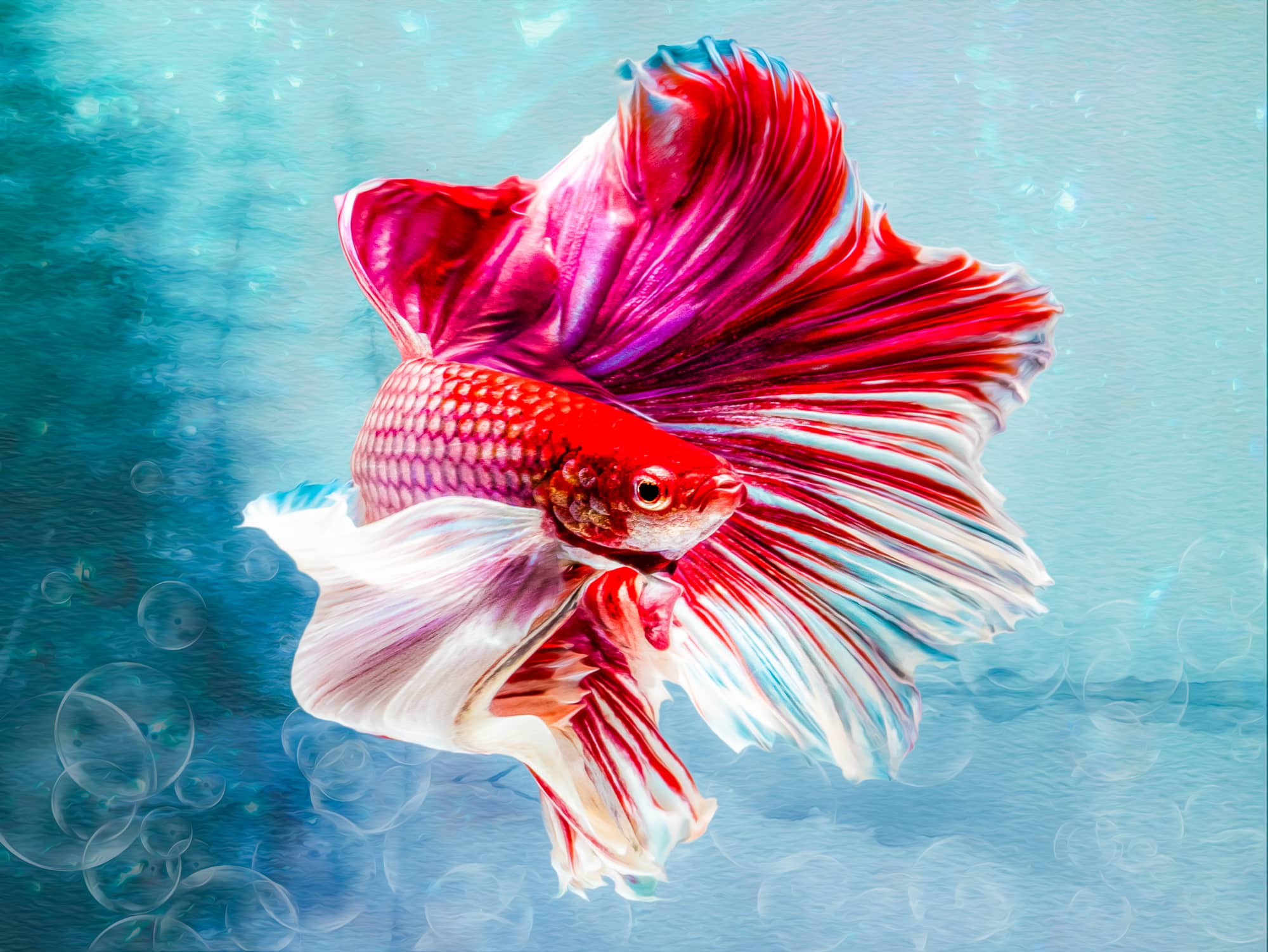The Butterfly male Betta is a stunning fish known for its vibrant colors and long, flowing fins. The males have a unique pattern where one solid color extends into the base of their fins, with the color stopping in a strong, distinct line.
These fish are typically white or transparent in the rest of their body. They have an aggressive temperament and should be kept alone or with compatible tank mates. In terms of size, Betta fish can grow up to 3 inches long.
The lifespan of a male Butterfly Betta fish can vary but typically ranges from 2 to 4 years with proper care.

Credit: fishlab.com
Table of Contents
Understanding The Butterfly Male Betta
The male Butterfly Betta, known for its stunning fins and vibrant colors, is a popular choice among fish enthusiasts. However, it’s important to note that they have an aggressive temperament. Proper care and understanding of their behavior is crucial for their well-being.
The Butterfly Male Betta, also known as Betta splendens, is a stunning and popular freshwater fish known for its vibrant colors and graceful movements. In this section, we will dive deeper into the characteristics and features of this beautiful species.
Appearance And Color Variations:
- The Butterfly Male Betta displays a wide range of colors, including shades of blue, red, yellow, and white.
- The body of the betta is typically elongated and slender, with flowing fins and a majestic tail.
- Each betta has its unique color pattern, but the butterfly pattern is particularly eye-catching. It is characterized by one solid color that extends into the base of its fins, with the color stopping in a distinct line. The rest of the body remains translucent or pale, creating a striking contrast.
- The fins and tails of the butterfly male betta are often white or transparent, enhancing its ethereal beauty.
Distinctive Features Of The Butterfly Male Betta:
- Majestic Fins: One of the most distinguishing features of the butterfly male betta is its elaborate fins. The long, flowing fins and tail give it a regal appearance, making it a captivating addition to any aquarium.
- Labyrinth Organ: Unlike most fish, bettas have a unique labyrinth organ that allows them to breathe air from the surface. This adaptation enables them to survive in low-oxygen environments, such as stagnant waters or rice paddies.
- Territorial Behavior: Male bettas are known for their territorial nature. They will fiercely guard their designated territory and may become aggressive towards other fish, particularly other male bettas. It is essential to provide them with enough space and hiding spots to minimize conflict.
- Playful Personalities: Despite their territorial disposition, butterfly male bettas can form a strong bond with their owners. With time and patience, they can become quite interactive and even recognize their caretaker.
- Long Lifespan: With proper care, butterfly male bettas can live for 2 to 4 years, making them a long-term commitment for their owners.
The butterfly male betta is a truly mesmerizing fish that adds beauty and elegance to any aquarium. Its vibrant colors, distinct patterns, and unique features make it a sought-after choice for fish enthusiasts. So, if you’re looking to add a splash of color and grace to your tank, the butterfly male betta is an excellent choice.
Caring For Your Butterfly Male Betta
Caring for your butterfly male betta requires attention to their aggressive temperament and specific tank conditions. These stunning fish are known for their beautiful fins and colors, making them a popular choice among fish enthusiasts.
Ly male betta have bold and vibrant colors, reminiscent of the delicate and intricate patterns found on butterfly wings. Caring for your butterfly male betta requires creating an ideal tank environment, ensuring proper water temperature and quality, providing a nutrient-rich diet, and setting up the perfect habitat.
Setting Up The Ideal Tank Environment:
- Choose a tank size of at least 5 gallons to provide ample space for your butterfly male betta to swim and explore.
- Use a heater to maintain a stable water temperature between 78-80°F, as bettas are tropical fish and thrive in warmer environments.
- Add a gentle filter to keep the water clean and properly aerated, but be cautious of strong currents that may stress your betta.
- Decorate the tank with live or silk plants, rocks, and caves to create hiding spots and mimic their natural habitat.
- Avoid sharp or rough decorations that can tear your betta’s delicate fins.
Water Temperature And Quality:
- Regularly check the water temperature using a reliable thermometer to ensure it remains within the recommended range.
- Conduct weekly water changes of about 25-30% to maintain good water quality and remove any accumulated toxins or waste.
- Use a water conditioner to neutralize harmful chemicals such as chlorine and chloramine.
- Test the water parameters, including pH, ammonia, nitrite, and nitrate levels, to ensure a healthy and stable environment for your betta.
Nutrition And Feeding Tips For Butterfly Male Bettas:
- Feed your betta a high-quality pellet or flake food specifically formulated for bettas.
- Offer a varied diet by supplementing their meals with frozen or live foods like bloodworms, daphnia, or brine shrimp.
- Feed your betta small portions two to three times a day, only providing what they can consume within a few minutes.
- Remember to remove any uneaten food to prevent water contamination.
- Consider occasional fasting days, allowing your betta’s digestive system to rest.
Creating The Perfect Habitat For Your Betta:
- Provide hiding places in the tank, such as caves or plants, to give your betta a sense of security.
- Ensure there are no sharp edges or surfaces that could damage their delicate fins.
- Maintain a regular and consistent lighting schedule, providing a balance between light and darkness to mimic natural day-night cycles.
- Avoid placing the tank in direct sunlight to prevent excessive heat and algae growth.
- Monitor your betta’s behavior and adjust the tank setup accordingly to meet their preferences and needs.
By following these guidelines, you can ensure that your butterfly male betta thrives in its environment. Remember to observe and interact with your betta regularly to build a strong bond and provide the best care possible.
Breeding And Reproduction Of Butterfly Male Bettas
The breeding and reproduction of butterfly male bettas can be a fascinating process. These bettas have stunning colors and fins, but they also have an aggressive temperament. Careful consideration and planning are necessary to ensure the health and success of the breeding process.
Butterfly male bettas are stunning and captivating fish that make excellent pets for fish enthusiasts. If you’re interested in breeding these beautiful creatures, it’s important to understand and follow the proper breeding and reproduction process. In this section, we will discuss the steps you need to take to successfully breed butterfly male bettas.
Introduction To Breeding Butterfly Male Bettas
Breeding butterfly male bettas can be a rewarding and exciting experience for fish keepers. However, it requires careful preparation and attention to detail. Here are the key points to consider when breeding butterfly male bettas:
- Breeding butterfly male bettas can help preserve and improve the species by producing healthy offspring with desirable traits.
- It is essential to have a suitable breeding environment, including a separate breeding tank and appropriate water conditions.
- Butterfly male bettas are known for their striking colors and delicate fins, making them a popular choice for hobbyists.
Preparing Your Bettas For Breeding
Before you begin the breeding process, it’s crucial to prepare your bettas to ensure their health and readiness. Here are the essential steps to follow when preparing your bettas for breeding:
- Select healthy and genetically diverse bettas for breeding. This will help ensure strong and vibrant offspring.
- Provide proper nutrition to your bettas by feeding them a balanced diet consisting of high-quality betta pellets, live or frozen foods.
- Condition your bettas for breeding by gradually increasing their food intake and introducing them to live foods like brine shrimp or daphnia.
- Create a suitable breeding environment by setting up a separate breeding tank with appropriate water temperature and quality.
- Introduce a male and female betta to the breeding tank, ensuring they have proper hiding spots and ample swimming space.
The Breeding Process Of Butterfly Male Bettas
Once you have prepared your bettas for breeding, it’s time to initiate the breeding process. Follow these steps to maximize your chances of successful reproduction:
- Observe courtship behavior: The male betta will build bubble nests and perform elaborate displays to attract the female.
- Introduce the female to the male’s bubble nest once she shows signs of readiness, such as vertical stripes or a receptive posture.
- Allow the male to embrace the female and release her eggs. The male will then gather the eggs and place them in the bubble nest for protection.
- Remove the female from the breeding tank after spawning to prevent aggression from the male.
- Monitor the bubble nest and ensure that it remains intact. If the nest is damaged, carefully repair it or provide a backup bubble nest.
- Maintain proper water conditions in the breeding tank, including temperature, pH, and filtration, to promote the development of the eggs.
- After a few days, the eggs will hatch into fry. At this stage, it is crucial to remove the male from the tank to prevent cannibalism.
- Feed the fry with infusoria or powdered fry food until they are large enough to consume baby brine shrimp or crushed flakes.
Breeding butterfly male bettas requires patience, dedication, and attention to detail. By following these steps, you can increase the chances of successful reproduction and enjoy the beauty of these remarkable fish. Remember to always prioritize the health and well-being of your bettas throughout the breeding process.
Frequently Asked Questions For Butterfly Male Betta
How Big Do Butterfly Bettas Get?
Butterfly bettas can grow up to 2. 5 inches in size.
What Makes A Betta A Butterfly?
A betta becomes a butterfly when it has one solid color that extends into the base of its fins, with the color stopping in a distinct line while the body remains translucent or pale. The fins and tails are typically white or transparent.
How Long Do Butterfly Male Betta Fish Live?
Butterfly male betta fish typically live for about 2 to 3 years.
What Is The Rarest Betta Fish?
The rarest betta fish is the True Purple Betta, known for its solid purple color, which can sell for thousands due to the time and effort required to create it.
Conclusion
The male Butterfly Betta is a stunning fish with its vibrant colors and intricate fin patterns. However, it is important to note that they have an extremely aggressive temperament, so they are best kept in a tank by themselves. Their unique butterfly pattern, where one solid color extends into the base of their fins, adds to their beauty and appeal.
As a betta owner, it is crucial to provide them with proper care and attention to ensure their well-being. Understanding their behaviors and needs, such as a moderate level of care and an appropriate tank setup, will contribute to their longevity.
While they may live for several years if properly cared for, it is essential to remember that they are living creatures that require dedication and commitment. If you are a fan of bettas and want a visually striking fish that stands out, the male Butterfly Betta is an excellent choice.









